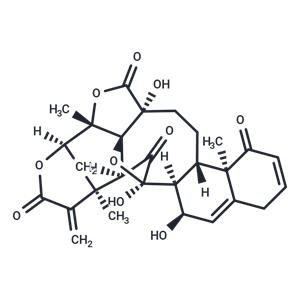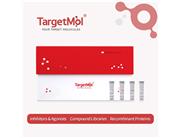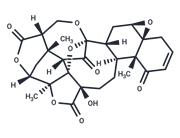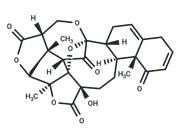| Name | Physalin A |
| Description | Physalin A is an anti-inflammatory compound isolated from P. alkekengi with anti-fibrotic effects, regulating the Nrf2 pathway through ERK and p38 to induce detoxification enzymes. Physalin A blocks the activation of the NF-kappaB signaling pathway. Physalin A reduces mammosphere formation by reducing the expression of the GLI1 gene and the YAP1 gene. |
| In vitro | To detect the growth inhibition effects of Physalin A on different human tumor cell lines (HT1080 fibrosarcoma, A375-S2 melanoma, HepG2 hepatoma, HeLa cervical carcinoma, A549 alveolar basal epithelial, U937 histocytic lymphoma, HCT116 colon cancer, A431 epidermoid carcinoma, MCF7 breast cancer, and HL60 promyelocytic leukemia cells), the cells were cultured with 0, 10, 20, 40, and 80 μM Physalin A for 24 h. HT1080 and A375-S2 cells were the most sensitive tumor cell lines among those used. Physalin A inhibited HT1080 cell growth in a time- and dose-dependent manner with an IC50 value (at 24 h) of 10.7 μM. [1] |
| In vivo | After anesthetization with 1% pentobarbital (100 µl/10 g body weight, intraperitoneal administration), 24 mice were randomly selected and grouped (the DMM group and the DMM + Physalin A group) for destabilized medial meniscus (DMM) surgery. Three groups were administered intra-articular injections with different treatments, twice per week. The sham and DMM groups received 10 μl of the vehicle (30% PEG300, 5% DMSO, and ddH2O), whereas the DMM + Physalin A group received 10 μl of Physalin A (1 mg/kg body weight). Physalin A decreasing MMP13 production and increasing collagen II and aggrecan production in the in vivo mouse OA model. The OARSI score also indicated that injecting Physalin A into the knee joint cavity could ameliorate the progression of OA in the mouse model. [2] |
| Storage | keep away from moisture,keep away from direct sunlight,store at low temperature | store at -20°C | Shipping with blue ice. |
| Keywords | Physalin A |
| Inhibitors Related | Stavudine | Meclizine dihydrochloride | Sodium 4-phenylbutyrate | L-Ascorbic acid | Hydroxychloroquine | Guanidine hydrochloride | Taurine | Tributyrin | Curcumin | Paeonol | Naringin | Gefitinib |

 United States
United States



